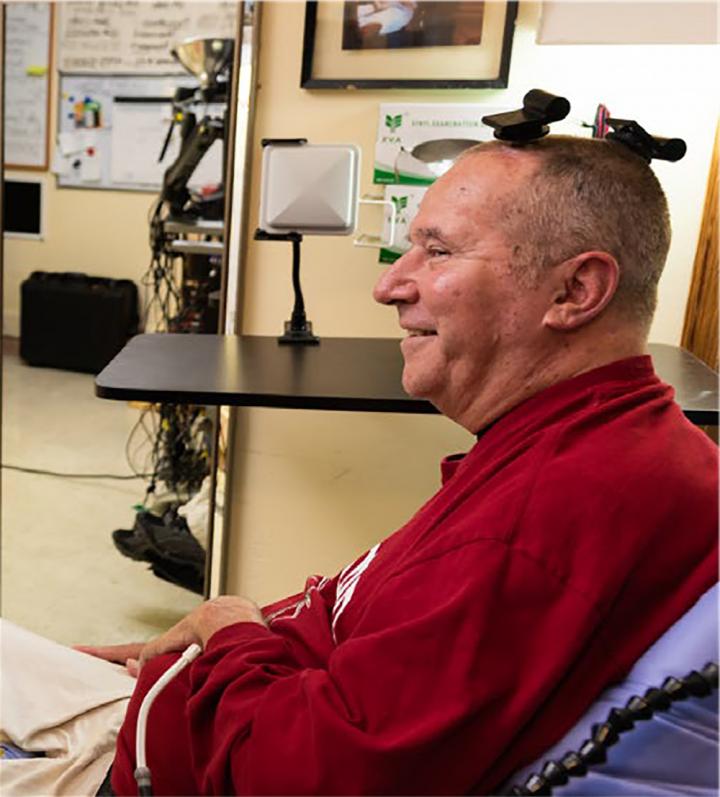
Credit: Braingate.ord
PROVIDENCE, R.I. [Brown University and Providence Veterans Affairs Medical Center] — Brain-computer interfaces (BCIs) are an emerging assistive technology, enabling people with paralysis to type on computer screens or manipulate robotic prostheses just by thinking about moving their own bodies. For years, investigational BCIs used in clinical trials have required cables to connect the sensing array in the brain to computers that decode the signals and use them to drive external devices.
Now, for the first time, BrainGate clinical trial participants with tetraplegia have demonstrated use of an intracortical wireless BCI with an external wireless transmitter. The system is capable of transmitting brain signals at single-neuron resolution and in full broadband fidelity without physically tethering the user to a decoding system. The traditional cables are replaced by a small transmitter about 2 inches in its largest dimension and weighing a little over 1.5 ounces. The unit sits on top of a user’s head and connects to an electrode array within the brain’s motor cortex using the same port used by wired systems.
For a study published in IEEE Transactions on Biomedical Engineering, two clinical trial participants with paralysis used the BrainGate system with a wireless transmitter to point, click and type on a standard tablet computer. The study showed that the wireless system transmitted signals with virtually the same fidelity as wired systems, and participants achieved similar point-and-click accuracy and typing speeds.
“We’ve demonstrated that this wireless system is functionally equivalent to the wired systems that have been the gold standard in BCI performance for years,” said John Simeral, an assistant professor of engineering (research) at Brown University, a member of the BrainGate research consortium and the study’s lead author. “The signals are recorded and transmitted with appropriately similar fidelity, which means we can use the same decoding algorithms we used with wired equipment. The only difference is that people no longer need to be physically tethered to our equipment, which opens up new possibilities in terms of how the system can be used.”
The researchers say the study represents an early but important step toward a major objective in BCI research: a fully implantable intracortical system that aids in restoring independence for people who have lost the ability to move. While wireless devices with lower bandwidth have been reported previously, this is the first device to transmit the full spectrum of signals recorded by an intracortical sensor. That high-broadband wireless signal enables clinical research and basic human neuroscience that is much more difficult to perform with wired BCIs.
The new study demonstrated some of those new possibilities. The trial participants — a 35-year-old man and a 63-year-old man, both paralyzed by spinal cord injuries — were able to use the system in their homes, as opposed to the lab setting where most BCI research takes place. Unencumbered by cables, the participants were able to use the BCI continuously for up to 24 hours, giving the researchers long-duration data including while participants slept.
“We want to understand how neural signals evolve over time,” said Leigh Hochberg, an engineering professor at Brown, a researcher at Brown’s Carney Institute for Brain Science and leader of the BrainGate clinical trial. “With this system, we’re able to look at brain activity, at home, over long periods in a way that was nearly impossible before. This will help us to design decoding algorithms that provide for the seamless, intuitive, reliable restoration of communication and mobility for people with paralysis.”
The device used in the study was first developed at Brown in the lab of Arto Nurmikko, a professor in Brown’s School of Engineering. Dubbed the Brown Wireless Device (BWD), it was designed to transmit high-fidelity signals while drawing minimal power. In the current study, two devices used together recorded neural signals at 48 megabits per second from 200 electrodes with a battery life of over 36 hours.
While the BWD has been used successfully for several years in basic neuroscience research, additional testing and regulatory permission were required prior to using the system in the BrainGate trial. Nurmikko says the step to human use marks a key moment in the development of BCI technology.
“I am privileged to be part of a team pushing the frontiers of brain-machine interfaces for human use,” Nurmikko said. “Importantly, the wireless technology described in our paper has helped us to gain crucial insight for the road ahead in pursuit of next generation of neurotechnologies, such as fully implanted high-density wireless electronic interfaces for the brain.”
The new study marks another significant advance by researchers with the BrainGate consortium, an interdisciplinary group of researchers from Brown, Stanford and Case Western Reserve universities, as well as the Providence Veterans Affairs Medical Center and Massachusetts General Hospital. In 2012, the team published landmark research in which clinical trial participants were able, for the first time, to operate multidimensional robotic prosthetics using a BCI. That work has been followed by a steady stream of refinements to the system, as well as new clinical breakthroughs that have enabled people to type on computers, use tablet apps and even move their own paralyzed limbs.
“The evolution of intracortical BCIs from requiring a wire cable to instead using a miniature wireless transmitter is a major step toward functional use of fully implanted, high-performance neural interfaces,” said study co-author Sharlene Flesher, who was a postdoctoral fellow at Stanford and is now a hardware engineer at Apple. “As the field heads toward reducing transmitted bandwidth while preserving the accuracy of assistive device control, this study may be one of few that captures the full breadth of cortical signals for extended periods of time, including during practical BCI use.”
The new wireless technology is already paying dividends in unexpected ways, the researchers say. Because participants are able to use the wireless device in their homes without a technician on hand to maintain the wired connection, the BrainGate team has been able to continue their work during the COVID-19 pandemic.
“In March 2020, it became clear that we would not be able to visit our research participants’ homes,” said Hochberg, who is also a critical care neurologist at Massachusetts General Hospital and director of the V.A. Rehabilitation Research and Development Center for Neurorestoration and Neurotechnology. “But by training caregivers how to establish the wireless connection, a trial participant was able to use the BCI without members of our team physically being there. So not only were we able to continue our research, this technology allowed us to continue with the full bandwidth and fidelity that we had before.”
Simeral noted that, “Multiple companies have wonderfully entered the BCI field, and some have already demonstrated human use of low-bandwidth wireless systems, including some that are fully implanted. In this report, we’re excited to have used a high-bandwidth wireless system that advances the scientific and clinical capabilities for future systems.”
###
Brown has a licensing agreement with Blackrock Microsystems to make the device available to neuroscience researchers around the world. The BrainGate team plans to continue to use the device in ongoing clinical trials.
Other authors on this latest research were Thomas Hosman, Jad Saab, Marco Vilela, Brian Franco, Jessica Kelemen, David Brandman, John Ciancibello, Paymon Rezaii, Emad Eskandar, David Rosler, Krishna Shenoy and Jaimie Henderson.
The work was supported in part by NIH BRAIN Initiative – NINDS (UH2NS095548), the Department of Veterans Affairs (N9228C, N2864C, A2295R, B6453R, P1155R); NIH-NIDCD (R01DC009899, R01DC014034); NIH-NIBIB (R01EB007401); the Executive Committee on Research (ECOR) of Massachusetts General Hospital; MGH-Deane Institute; DARPA REPAIR; Wu Tsai Neurosciences Institute at Stanford; Larry and Pamela Garlick; Samuel and Betsy Reeves; the Howard Hughes Medical Institute at Stanford University and Conquer Paralysis Now (004698).
Disclosure: Arto Nurmikko is an inventor of wireless neural device U.S. Patent #10433754. The content is solely the responsibility of the authors and does not necessarily represent the official views of the NIH, the Department of Veterans Affairs or the U.S. Government.
Caution: Investigational device. Limited by federal law to investigational use.
Media Contact
Kevin Stacey
[email protected]
Original Source
https:/
Related Journal Article
http://dx.




